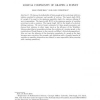Free Online Productivity Tools
i2Speak
i2Symbol
i2OCR
iTex2Img
iWeb2Print
iWeb2Shot
i2Type
iPdf2Split
iPdf2Merge
i2Bopomofo
i2Arabic
i2Style
i2Image
i2PDF
iLatex2Rtf
Sci2ools
CORR
2010
Springer
2010
Springer
Logical complexity of graphs: a survey
We discuss the definability of finite graphs in first-order logic with two relation symbols for adjacency and equality of vertices. The logical depth D(G) of a graph G is equal to the minimum quantifier depth of a sentence defining G up to isomorphism. The logical width W(G) is the minimum number of variables occurring in such a sentence. The logical length L(G) is the length of a shortest defining sentence. We survey known estimates for these graph parameters and discuss their relations to other topics (such as the efficiency of the WeisfeilerLehman algorithm in isomorphism testing, the evolution of a random graph, or the contribution of Frank Ramsey to the research on Hilbert's Entscheidungsproblem). Also, we trace the behavior of the descriptive complexity of a graph as the logic becomes more restrictive (for example, only definitions with a bounded number of variables or quantifier alternations are allowed) or more expressible (after powering with counting quantifiers). Date: ...
Alexander Von Humboldt Foundation | CORR 2010 | Education | Minimum Quantifier Depth | Shortest Defining Sentence |
| Added | 09 Dec 2010 |
| Updated | 09 Dec 2010 |
| Type | Journal |
| Year | 2010 |
| Where | CORR |
| Authors | Oleg Pikhurko, Oleg Verbitsky |
Comments (0)

